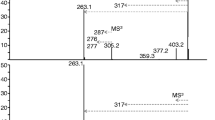Abstract
Two human liver UDP-glucuronosyltransferase cDNA clones, HLUG25 and UDPGTh2 were previously shown to encode isozymes active in the glucuronidation of hyodeoxycholic acid (HDCA) and certain estrogen derivatives (e.g., estriol and 3,4-catechol estrogens), respectively. In this study we have found that the UDPGTh-2-encoded isoform (UDPGTh2) and HLUG25-encoded isoform (UDPGTh1) have parallel aglycone specificities. When expressed in COS 1 cells, each isoform metabolized three types of dihydroxy- or trihydroxy-substituted ring structures, including the 3,4-catechol estrogen (4-hydroxyestrone), estriol, 17-epiestriol, and HDCA, but the UDPGTh2 isozyme was 100-fold more efficient than UDPGTh1. UDPGTh1 and UDPGTh2 were 86% identical overall (76 differences out of 528 amino acids), including 55 differences in the first 300 amino acids of the amino terminus, a domain which conferred the substrate specificity. The data indicated that a high level of conservation in the amino terminus was not required for the preservation of substrate selectivity. Analysis of glucuronidation activity encoded by UDPGTh1/UDPGTh2 chimeric cDNA constructed at their common restriction sites,Sac 1 (codon 297),Nco 1 (codon 385), andHha 1 (codon 469), showed that nine amino acids between residues 385 and 469 were important for catalytic efficiency, suggesting that this region represented a domain which was critical for the catalysis but distinct from that responsible for aglycone selection. These data indicate, that UDPGTh2 is a primary isoform responsible for the detoxification of the bile salt intermediate as well as the active estrogen intermediates.
Similar content being viewed by others
References Cited
Ahn, M. R., Owens, I. S. and Sheen, Y. Y., Expression of human liver 3,4-catechol estrogens.Arch. Pharm. Res., 20, in press (1997).
Burchell, B., Identification and purification of multiple forms of UDP-glucuronosyl-transferase.Rev. Biochem. Toxicol., 3, 1–32 (1981).
Chowdhury, R. J., Chowdhury, N. R., Falany C. N., Tephly T. R. and Arias I. M., Isolation and characterization of multiple form of rat liver UDP-glucuronosyltransferase.Biochem. J., 233, 827–837 (1986).
Dutton, G. J.,Glucuronidation of drugs and other compounds. CRC Inc. Florida USA pp. 69–78, 1980.
Fournel-Gigleux, S., Jackson, M. R., Wooster, R. and Burchell, B., Expression of a human liver cDNA encoding a UDP-glucuronosyltransferas catalysing the glucuronidation of hyodeoxycholic acid in cell culture.FEBS Lett., 243, 119–122 (1989).
Harding D., Jackson M., Couterie W. H. and Burchull B., Phenol UDP-glucuronosyl transferase deficiency in Gunn rats:mRNA levels are considerably reduced.Biochem. Pharm., 38, 1013–1017 (1989).
Irani, E. N., Wheatherill, S. M., Keneddy, M. E. and Burchell, B., The inherited deficiency of hepatic UDP-glucuronosyltransferase: structure activity relationship ofin vitro stimulators.Biochem. Pharmacol., 29, 2367–2371 (1980).
Iyanagi, T., Haniu, M., Sogawa, K., Fujii-Kuriyama, Y., Watanabe, S., Shively, J. E. and Anan, K. F., Cloning andcharacterization of cDNA encoding 3-methylcholanthrene inducible rat mRNA for UDP-glucuronosyltransferase.J. Biol. Chem., 261, 15607–15614 (1986).
Jackson, M. R., McCarthy, L. R., Harding, D., Wilson, S., Coughtrie, M. W. H. and Burchell, B., Cloning of a human liver microsomal UDP-glucurosyltransferase cDNA.Biochem. J., 242, 581–588 (1987).
Jackson M., McCarthy, L. R., Hardings, D., Wilson, S., Couterie, W. H. and Burchull, B., Cloning of human liver microsomal UDP-glucuronosyl transferase cDNA.Eur. J. Biochem., 242, 581–588 (1987).
Kimura, T. and Owens, I. S., Mouse UDP-glucuronosyl transferase cDNA and complete amino acid sequence and regulation.Eur. J. Biochem., 168, 515–521 (1987).
Lilienblum, W., Walli, A. K. and Bock, K. W., Differential induction of rat liver microsomal UDP-glucuronosyltransferase activities by various inducing agents.Biochem. Pharmacol., 31, 907–913 (1980).
Author information
Authors and Affiliations
Rights and permissions
About this article
Cite this article
Kim, S.S., Owens, I.S. & Sheen, Y.Y. Comparison of glucuronidating activity of two human cDNAs, UDPGTh1 and UDPGTh2. Arch. Pharm. Res. 20, 454–458 (1997). https://doi.org/10.1007/BF02973939
Received:
Issue Date:
DOI: https://doi.org/10.1007/BF02973939




